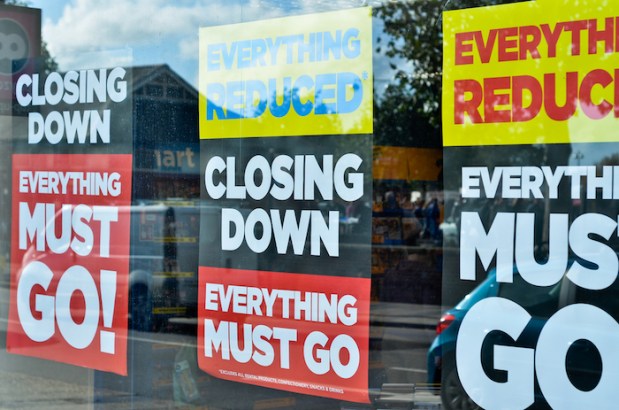So Far, 2016 Is A Boom Year For Retail Bankruptcies

This time last year, U.S. companies were going bankrupt at a rate nobody had seen in half a decade. More than 26,000 companies bit the bullet in Q1 2015, giving pundits reasonable cause to worry about the future solvency of the organizations that remained.
Over the next several quarters, the overall pace of bankruptcies mercifully slowed. In fact, in Q1 2016, Chapter 11 filings from commercial companies actually fell 5 percent across the board.
Absolutely no need to panic, then — unless the topic is retail bankruptcies, which increased year over year by 24 percent. Yes, that seems an appropriately fine number to panic over.
Such is the double-edged sword of a retail industry swept up in innovation. For every new path cut through the market, the retailers standing in the way are cut down. Just a few short months into 2016, several standbys have already filed the appropriate paperwork to try to drag themselves slowly back to the black, while others are heading towards complete liquidation. But, for every dearly departed retailer so far in 2016, are there lessons to be learned by those that are still struggling to survive?
February — Hancock Fabrics
In 2007, Hancock Fabrics filed for Chapter 11 bankruptcy protection and closed more than a 100 stores in a year-long restructuring process. As of Feb. 2, 2016, a new set of financial difficulties forced the fabric and crafts chain to agree to shutter yet another 70 locations, while opening liquidation sales at its remaining 180-odd stores. As of the filing date, the retailer reported debt totals of $182 million, with remaining assets of $151 million.
March — Sports Authority
Though the sporting goods retailer originally filed for bankruptcy in March, claiming upwards of $1.1 billion in debt — $36 million of which is owed to the NFL’s Denver Broncos — the arguably more interesting points in its path to insolvency have come in the following months. It wasn’t until early April that Sports Authority’s lawyers managed to win a favorable decision in a protracted legal fight with suppliers over the right to sell consigned inventory as a means of eventually righting the ship and exiting bankruptcy, a la Hancock Fabrics’ 2007 foray into financial uncertainty.
A month later, Sports Authority is still stuck between finding a buyer to support reorganization and pulling the plug on it all and liquidating what assets remain. If the chain can’t find a taker by May 16, leases on 140 defunct brick-and-mortar store fronts are set to go up for public auction.
It’s a stark reminder that retailers may no longer have the luxury of bankruptcy to fall back on if their debts spiral out of control alongside dwindling revenue. Try as they might to reorganize — a lawyer for Sports Authority claimed that “liquidation is not in our vocabulary” — it’s becoming increasingly clear that some legacy retailers simply don’t have control of their financial fates anymore.
April — Vestis
Vestis Retail Group might not be a well-known name in retail, but the properties it manages — Eastern Mountain Sports, Bob’s Stores and Sport Chalet — most certainly are. Or, more appropriately for Sport Chalet, were.
Vestis announced its plans to file for Chapter 11 on April 18, though the move wasn’t meant as a wholesale indictment of its brands’ performance. Rather, the move was made in an attempt to cut the chaff of Sport Chalet from the wheat of EMS and Bob’s, which Vestis CEO Mark Walsh explained couldn’t be given the resources they needed due to Sport Chalet’s mounting debt and falling revenue.
It’s a perfect example of the needs of the many outweighing the needs of the few in modern retail. If an asset isn’t pulling its weight in the markets, it’s more likely than not pulling other brands down with it.
May — Aéropostale
Retail’s 2016 bankruptcies kicked off with an apparel brand that grew off the back of the obsolete preference for in-person mall shopping, and it’s further confirmation of fast-fashion’s killer instinct that a similar retailer — product of mall culture Aéropostale — has declared its intention to kick the Chapter 11 bucket, too.
It’s something of a long time coming for Aéropostale, which has closed 215 store fronts since 2013 and plans to shutter 154 more as a result of the filing. In some form of a silver lining, the company is talking about plans to complete its bankruptcy motions within six months and begin restructuring on a smaller footprint. However, it’ll have to settle a brewing legal battle before that can happen.
Alongside its Chapter 11 filing, Aéropostale also made an official motion to open an investigation into MGF Sourcing, one of the retailer’s suppliers and subsidiary of Sycamore Partners, a former majority shareholder in the chain and its largest secured lender. While Aéropostale CEO Julian Geiger is alleging that MGF offered inflated prices on merchandise, causing it to overpay by $25 million, Sycamore Managing Director Stefan Kaluzny argued that “any such action would be counterproductive to [Sycamore’s] large financial investment in [Aéropostale].”
